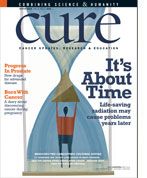Publication
Article
CURE
Ushering in the New in Radiation
Author(s):
Late effects of radiation makes an impact on leading radiation oncologist.
Anthony Zietman, MD, chair of the American Society for Radiation Oncology (ASTRO), understands firsthand the late effects of radiation. His sister Kim was diagnosed with stage 2A Hodgkin lymphoma at age 22 in 1984, when Zietman was a medical resident. She received the standard treatment of the time, which Zietman calls “radiation from stem to stern, with old technology and all from the front.”
Though she is cured—and that’s wonderful—over the last 26 years, she has had a number of complications, including a heart attack and coronary bypass at 40 in 2002,” Zietman says.
The last 15 years of radiation oncology have been very exciting. We have technology that allows us to treat the way we want to.
Zietman says that, were Kim diagnosed today, she would be treated with new “everything”: new philosophy, new technology and new treatment options, including chemotherapy.
“Chemotherapy is not without its issues and we are aware of those,” Zietman says. “With the volume of disease she had, she would also need radiation, but she’d get half what she was given then, and it would be artfully sculpted to the areas of known disease.”
The heart, breasts and lungs would also be carefully shielded, he adds.
“The last 15 years of radiation oncology have been very exciting,” Zietman says. “We have technology that allows us to treat the way we want to.”
The downside, he concedes, is that the technology has moved quickly, and there is some question about whether the ability to use and understand it has kept up.
Zietman says recent media attention about radiation safety issues has shaken the industry but has also given ASTRO impetus to implement a six-point patient protection plan designed to improve safety and quality while reducing chances of medical errors.
“The basic components of our safety plan were in place already,” he adds, “but there wasn’t a great deal of interest. Now we have traction. Every practice in the United States wants to prove it’s safe.”
ASTRO, the largest radiation oncology society in the world, works jointly with the American College of Radiology to accredit radiation delivery practices.
One of the six points presented by ASTRO calls for an “enhanced accreditation program” and addition of accreditation modules that address new technologies such as intensity-modulated radiation therapy, high-precision radiation that uses computer-controlled linear accelerators to deliver precise radiation; stereotactic body radiation therapy, a technique to deliver external-beam radiation with pinpoint accuracy; and brachytherapy, which uses a number of delivery methods to put the radiation into or next to the cancer internally.
Other points include tracking medical errors, expanding safety education training, creating tools to educate patients, developing a medical technologies compliance program and advocating for new national standards for radiation therapy team members.
Zietman says he expects radiation treatment to move in the direction of surgery in terms of checklists and verification.
“Before surgery there is a checklist, and there will be one for radiation oncology,” he explains. “All the pieces must be lined up, and a second therapist has to be there to verify everything has taken place. The computer checks the humans, and the humans check the computer.”
Radiation is like surgery in every other way, he adds, except for the knife.
When Kim began having chest pain, Zietman says, no one, including her primary care physician, suspected that a 40-year-old woman who exercised, ate right and didn’t smoke would have heart problems.
Then, two years later, Kim decided to have bilateral prophylactic mastectomy due to concerns about radiation-induced breast cancer.






